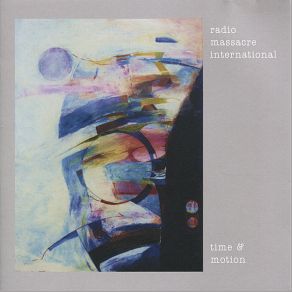Time & Motion
Download links and information about Time & Motion by Radio Massacre International. This album was released in 2010 and it belongs to Electronica, Rock, Progressive Rock genres. It contains 10 tracks with total duration of 02:37:04 minutes.

|
|
|---|---|
| Artist: | Radio Massacre International |
| Release date: | 2010 |
| Genre: | Electronica, Rock, Progressive Rock |
| Tracks: | 10 |
| Duration: | 02:37:04 |
| Buy it NOW at: | |
| Buy on iTunes $17.99 | |
| Buy on Amazon $17.98 | |
| Buy on iTunes $15.99 | |
Tracks
[Edit]| No. | Title | Length |
|---|---|---|
| 1. | Kairos | 17:10 |
| 2. | The Clockwork Time Dragon | 13:29 |
| 3. | Aeon | 10:40 |
| 4. | Chronos | 12:21 |
| 5. | Equatorial Pitch | 9:09 |
| 6. | Fission Ships, Part 1 | 15:42 |
| 7. | Maybe a Last Look at Joe's House | 14:42 |
| 8. | Fission Ships, Part 2 | 24:17 |
| 9. | Nine:Four:One | 21:17 |
| 10. | 30 Years (Slight Return) | 18:17 |
Details
[Edit]“Retro” and “electronica” seem rather oxymoronic in combination — if any musical genre could be considered forward-looking and futuristic, it would be electronica, whose artists are driven by the latest technological innovations and seem generally unconcerned about “maintaining the tradition.” And yet at the end of the new millennium’s first decade, Radio Massacre International have been luxuriating in the kind of spacy sounds that first hit the airwaves back in the mid-‘70s — think Phaedra, Tangerine Dream's groundbreaking Virgin Records debut released in 1974. This trio of Brits — Steve Dinsdale (electronics, drums), Duncan Goddard (electronics, bass), and Gary Houghton (guitar, electronics) — has released a gazillion albums since 1995’s Frozen North on the Centaur imprint; Cuneiform nabbed them in 2005, issuing the two-CD set Emissaries that year, followed by the Syd Barrett homage Rain Falls in Grey in 2007. Time & Motion, another Cuneiform two-disc opus, arrived in January 2010, so set the controls for deep space and, harking back to the old sequencer-driven synth music of the Berlin school, prepare for both forward rush and floating ambience over the more than two-and-a-half-hour journey. The opening 17-plus-minute “Kairos” begins with electronic raga-flavored washes and drones with guest Martin Archer's saxophone adding a Didier Malherbe flavor as the band tunes into a Radio Gnome frequency — it’s no surprise that Daevid Allen handled the Gong-ish cover art on Rain Falls in Grey. But then spaceship RMI kicks up the deep sequencer rhythm underneath it all, and the band is heading full-throttle to parts unknown. After a brief stop in harmonically unsettled, rhythmically free, and even painfully squealy territory, the deep repetitive rhythms kick in again beneath a Froese-like guitar and showers of sparkling sonic pinpoints, the aural equivalent of star-filled galaxies indeed.
Archer's lovely soprano humanizes “The Clockwork Time Dragon,” turning the midtempo synth pulse into true space jazz before deep dark ambience turns the interstellar dream into a nightmare. “Fission Ships, Pt. 1” might be the most “advanced” music on disc one — rhythmically free but often too eventful and ever-unfolding to be deemed ambient music, dark or otherwise. Also drawing from the avant side of electronica is the 24-plus-minute ominously rumbling “Fission Ships, Pt. 2” on disc two; also sans rhythm but far more diffuse and truly ambient, it could easily slip into the background for those not given to deep listening. This side of Time & Motion would be perfect as accompaniment for some zero-gravity housework, perhaps vacuum cleaning in a vacuum. “Aeon,” back on disc one, adds another ten-plus minutes of somewhat similar stuff, while the following multi-layered “Chronos” is positively punchy by comparison, interlocking rhythms developing a nice groove for a slo-mo dance party on an alien sphere. “A Last Look at Joe’s House,” the kickoff to the second disc, places Dinsdale behind the drum kit for the set’s biggest curve ball, with RMI in space rock mode as Houghton’s guitar soars, nearly Hendrixian, through the ether. It all wraps up nicely with “30 Years (Slight Return),” including the re-emergence of those sequencer rhythms and Archer’s jazzy sax truly integrated into the band’s unfolding music. Tripping across light years and well-paced between interludes of movement and stasis, Radio Massacre International's sound of the future may draw from the past, but remains unsurpassed in the electronica of the present. Sit back and enjoy the ride.